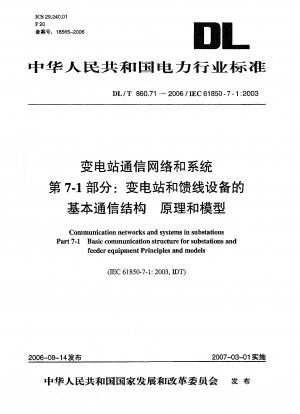DL/T 860.71-2006
Communication networks and systems in substations Part 7-1 Basic communication structure for substations and feeder equipment Principles and models (English Version)
- Standard No.
- DL/T 860.71-2006
- Language
- Chinese, Available in English version
- Release Date
- 2006
- Published By
- Professional Standard - Electricity
- Status
- 2015-03
- Replace By
- DL/T 860.71-2014
- Latest
- DL/T 860.71-2014
- Scope
- This section describes the modeling method, communication principles and information model of the DL/T 860.7 standard. This section starts from the concept of view to help readers understand the following basic modeling concepts and description methods: a) Substation-specific information model of the substation automation system; b) Equipment functions used for substation automation; c) Interaction provided in the substation Operational communication system. This section explains and provides detailed requirements between DL/T 860.74, DL/T 860.73, DL/T 860.72 and DL/T 860.5: and explains how DL/T 860.72DL/T 860.73, DL/T 860.74 maps to DL /T 860.81 specific communication protocol. The concepts and models of the DL/T 860 standard can also be used to describe information models and functions in the following applications: a) Information exchange between substations; b) Information exchange between substations and control centers; c) Information exchange for distribution automation; d) Information exchange for metering; e) Status monitoring and diagnosis (of high-voltage equipment); f) Engineering system information exchange for equipment configuration.
DL/T 860.71-2006 history
- 2014 DL/T 860.71-2014 Electric Power Automation Communication Networks and Systems Part 7-1: Basic Communication Architecture Principles and Models
- 2006 DL/T 860.71-2006 Communication networks and systems in substations Part 7-1 Basic communication structure for substations and feeder equipment Principles and models
